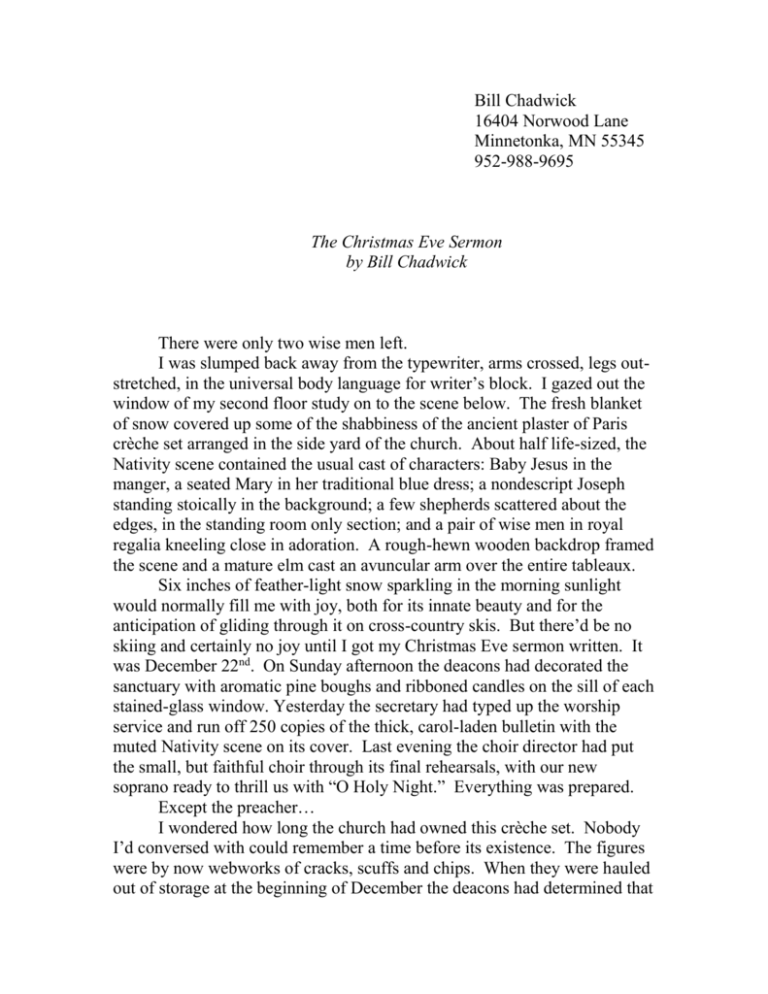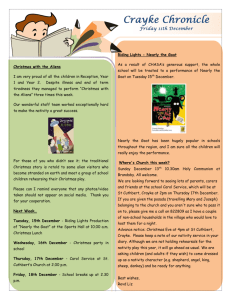Buster
advertisement

Bill Chadwick 16404 Norwood Lane Minnetonka, MN 55345 952-988-9695 The Christmas Eve Sermon by Bill Chadwick There were only two wise men left. I was slumped back away from the typewriter, arms crossed, legs outstretched, in the universal body language for writer’s block. I gazed out the window of my second floor study on to the scene below. The fresh blanket of snow covered up some of the shabbiness of the ancient plaster of Paris crèche set arranged in the side yard of the church. About half life-sized, the Nativity scene contained the usual cast of characters: Baby Jesus in the manger, a seated Mary in her traditional blue dress; a nondescript Joseph standing stoically in the background; a few shepherds scattered about the edges, in the standing room only section; and a pair of wise men in royal regalia kneeling close in adoration. A rough-hewn wooden backdrop framed the scene and a mature elm cast an avuncular arm over the entire tableaux. Six inches of feather-light snow sparkling in the morning sunlight would normally fill me with joy, both for its innate beauty and for the anticipation of gliding through it on cross-country skis. But there’d be no skiing and certainly no joy until I got my Christmas Eve sermon written. It was December 22nd. On Sunday afternoon the deacons had decorated the sanctuary with aromatic pine boughs and ribboned candles on the sill of each stained-glass window. Yesterday the secretary had typed up the worship service and run off 250 copies of the thick, carol-laden bulletin with the muted Nativity scene on its cover. Last evening the choir director had put the small, but faithful choir through its final rehearsals, with our new soprano ready to thrill us with “O Holy Night.” Everything was prepared. Except the preacher… I wondered how long the church had owned this crèche set. Nobody I’d conversed with could remember a time before its existence. The figures were by now webworks of cracks, scuffs and chips. When they were hauled out of storage at the beginning of December the deacons had determined that Bill Chadwick 2 the red-robed wise man was simply too damaged to be repaired one more time. He had finally succumbed to the effects of decades of silent vigil in Minnesota winters. The deacons had no choice but to retire him. Since the Nativity scene is set back about thirty feet from the road— precisely to hide its condition—it was decided that the rest of the crèche set was still “good enough” for now. The church members who were frantically searching for a new figure to replace the dearly departed Wise Man were having no success. This did not break my heart. Despite being a pastor—okay, because of being a pastor—I have never been much of a fan of Nativity scenes. Here in Minnesota the live outdoor Nativity scenes are simply ridiculous—and thankfully rare—because the costumes never fully conceal the snowmobile suits underneath. And the still life scenes always have seemed too reverential, antiseptic and…well, still, for what must have been earthy, chaotic and confusing. Birth is exciting and loud and messy enough all by itself. Throw in dazzling and terrifying angels (every time an angel shows up in the Bible the first thing he has to do is to say, “Don’t be afraid!”), and a few scruffy and smelly shepherds (probably particularly smelly after wetting their pants when the angels appeared). Add some weird astrologers from a strange, far-off land bringing bizarre gifts that were, in fact, symbols of tribute as a vassal might bring to a king, assorted goats, chickens, donkeys, cows… Top it all off with a heavenly lighthouse beam showing the way and you’ve got quite a party! So my problem with typical Nativity scenes is that they give a sense of the original events about as much as a postcard does justice to Mardi Gras. Add in the deteriorating condition of this particular crèche set and the irritating fact that the figures had complexions more Norwegian than Judean and, in sum, I was not a big fan of our church’s Nativity scene. But nobody asked my opinion and I kept it to myself. Of course, to be fair, I wondered if Nativity scenes aren’t attempting the impossible. Incarnation is such a sweet mystery: the idea that God— God!— somehow was embodied in a baby born long ago in Bethlehem. How can anything do justice to that? Precisely my problem at the moment. As a pastor I had always found the “High Holy Days” of Christmas and Easter to be the hardest to preach. Everyone knows the stories so well. What does one say that is fresh and insightful? And brief? For it’s a daunting crowd on Christmas Eve. The early service, five o’clock, is full of antsy children who understandably can’t wait to get home and open presents. At the eleven o’clock candlelight service it’s pretty much Bill Chadwick 3 adults. They have just finished a month-long marathon of buying and baking and bustling, of wrapping and writing and wrangling, of hosting and toasting and Christmas card-posting... a month-long marathon run at the pace of a sixty-yard dash. Now it’s Christmas Eve and people truly want to be attentive and worshipful. But on top of the last month’s frenzied schedule, this evening they have consumed great quantities of food and, many of them, a libation or three. The sanctuary lights are down low. The candles give off a drowsy scent. People doze. This was the challenge facing me. Fifty-four hours to go and I was trying desperately to think of something new to say. Or if not new, something that would at least be interesting enough to keep people from snoring. But I was drawing a blank. It occurred to me, not for the first time, that Christmas is not about words. In fact, God chose to become flesh precisely because words didn’t do it. For centuries, prophets and teachers had tried to tell people what God was like, using words such as “compassion” and “justice,” but the people didn’t get it. They needed to be shown. And so that Bethlehem baby—born in a stable, with a feedbox for a cradle—grew to be a special man, a person that many people understood to be the very incarnation of God’s grace and love. Yes, Jesus talked about God. But he also in some mysterious way embodied God. Indeed, Christmas is not about words. Still, the congregation will be expecting a sermon. In words. Looking down on the Nativity scene I tried to imagine myself joining that first motley collection of worshippers. If I were to journey to the manger, what symbol of love would I bring to the Christ Child? What eloquent words of adoration would I say? Perhaps such an exercise would jump-start my brain… Or not. Minutes passed. I took off my glasses, rubbed my eyes and massaged my temples and forehead. Opening my eyes I spotted a lone pedestrian coming down the main street sidewalk. That sidewalk is the city’s responsibility and it had not yet been cleared of the snow that fell the previous night. As I replaced my glasses the figure came into focus. With a jolt of recognition I leaned sideways for a better view around the leafless birch shivering outside my window. Wool pants, several layers of grimy wool sweaters, woolen stocking cap, woolen gloves, a long woolen scarf trailing behind. All drab brown and olive, not a bit of color. A complexion that epitomized the word “swarthy.” A bit on the short side, but with the neck and shoulders of a prizefighter, and Bill Chadwick 4 carrying a Billy club, shuffling in a semi-jog through the snow. Buster! I was delighted to see him, I realized with amazement. (Delighted to see him from the security of my second floor study.) It had been years since I had last spotted him around town and I was grateful to discover that he was still alive and out and about. I thought back to the first time I saw him, shortly after I moved to town a dozen years earlier. I was driving in my car near our little downtown and he was jogging along the sidewalk in an irregular sort of shuffling, forward-leaning-gait. He was wearing nearly the identical get-up—wool pants, wool sweaters, wool cap. But it had been August. Not one of those surprisingly cool lateAugust evenings, but a typical August noonday: eighty-five degrees and humid. He was talking to himself. But unlike many mentally ill people who seem totally inward-focused, this man was continually swiveling his head and looking around, jogging backwards and sideways to take in his surroundings and, not infrequently, to yell at people in cars passing by. And to shake his nightstick at them. I would see him once or twice a year, always jogging along the downtown sidewalks, always in the same attire and carrying the club. I had great compassion for this poor soul. But I’m not ashamed to say I found him very frightening. One summer day I myself was out jogging. I had a regular route, out past the lake on the edge of town and then, after a couple miles, I’d turn around and run back. One day, on the return portion of the out-and-back route, I rounded a bend. There he was. About 100 yards ahead, jogging toward me on the same side of the road: brown wool pants, olive-green wool sweater and wool cap in the eighty-degree heat. Shuffle-jogging. Talking to unseen demons. Nightstick in hand. Previously I’d only seen him from the safety of my car. My chest tightened and my breath came in quick, shallow pants. I frantically did a 360-degree search for either shelter or an escape route. There were no houses. There were no side streets. There were no cars coming. It was either turn around and run out into the country, for who knows how long—he was in way better shape than I—or take my chances on getting past him safely. I reasoned that he must be harmless or the authorities wouldn’t allow him to roam the streets. Right? I desperately tried to convince myself that this was true. But then I thought about how changes in governmental policy concerning persons with mental illness had recently de-institutionalized an Bill Chadwick 5 awful lot of folks. Folks who were now out on the streets, for good or bad. With a silent prayer for protection, I decided to continue. I crossed over to the other side of the road and jogged slowly on. As the distance between us lessened I looked straight ahead, pretending to be oblivious to him. In fact, I was intensely aware of his every move. He was staring at me, eyes narrowed, scowling, as he shuffle-jogged. As we came opposite one another he stopped, grimaced at me, growled some unintelligible words, and shook his club. Heart hammering as if it wanted to leave without waiting for the rest of me, I picked up my pace considerably, grateful for the magical powers of fear-induced adrenaline. No longer pretending to ignore him, I kept glancing back to see if he was following. He was looking toward me, hollering, and threatening with his nightstick, but he wasn’t coming my way. Finally, after a half-mile or so I relaxed. In talking with folks around town over the years I learned a little about this man for whom life seemed so tortured. His name was Buster. How perfect is that? He wasn’t born with a problem, but had lived a perfectly normal childhood, starring in sports. Turns out my first impression had been right. He not only was built like a prizefighter; he had, in fact, been one. And that was his problem now: brain-injured, permanently “punch drunk.” Now here he was in the familiar shuffle-jog, plowing a meandering furrow through the half-foot of fluffy snow. He hadn’t changed a bit in the several years since I had last seen him. I was grateful for the distraction, allowing me to ignore the blank sheet of paper in my typewriter and my dilemma. As usual, Buster was muttering to himself and swiveling his body to take in everything around him—a passing pickup, the new red-brick City Hall building across the street, a flock of sparrows chittering past, our quaint stone church. Suddenly he spotted the crèche figures, the Holy Family in aging plaster-of-Paris. He veered off the sidewalk and started tromping through the snow toward them, billy club gripped in his right hand. I sucked air audibly through my teeth and bit my lower lip. Leaning so close to the window that I sensed the cold on my forehead; my breath would have fogged the pane had I remembered to breathe. From the safety of my second story window I silently pleaded, “Don’t touch anything!” Though not personally fond of the crèche set, I still didn’t want this symbol of holiness damaged. As Buster neared the Nativity scene his pace slowed. He almost Bill Chadwick 6 tiptoed the last few steps and then stopped, front and center. He slowly looked from figure to figure—shepherds…two wise men…Joseph…Mary… a little congregation, gathering around the central mystery of our faith, all of them so vulnerable and exposed. Then Buster reverentially dropped to his knees, set down his club, and removed his gloves. Gently, oh-so-gently, with his bare fingers, Buster brushed the snow off the baby Jesus. The third Wise Man had arrived.







